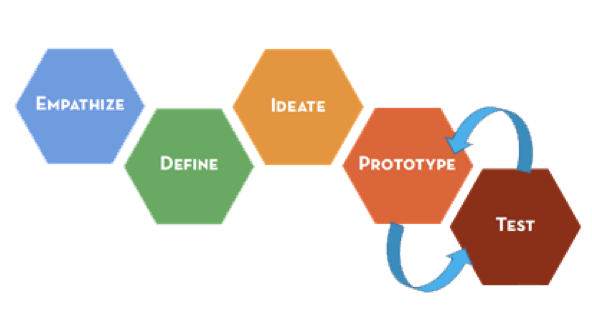This is the fourth post in the 10-part series on innovation, provided by Dr. Michael Murray.Earlier posts addressed questions of “what” innovation is and “who” the innovators are. This month’s piece continues to address the “how” of innovation. (For the introductory post on “Innovation – How to Do It”, see Part I posted on September 13, 2017.)
The Design Thinking/Human Centered Design model1-3 is a method for uncovering opportunities, creating possible solutions, and testing and refining these solutions with the people who will use them. This methodology evolved from the work done by the design firm IDEO, but it’s not just for product design. It is used to design solutions for a variety of challenges and opportunities, including significant social issues like education and access to health care, as well as more mundane challenges. This methodology describes a sequence of activities that is intended to allow us to learn, rather than guess, what our potential users want and determine whether we can deliver it. It is an iterative process that progressively reduces uncertainty, ideally utilizing resources (time, money, manpower) in a highly efficient manner.

The starting point for the Design Thinking process is EMPATHIZE. The word empathy evokes many interpretations, and one can find numerous, often incongruent definitions. Part of the problem lies with the fact that “empathy” is not one thing. In fact, there is affective empathy, which is subjectively experiencing the emotions of others, and there is cognitive empathy, which is understanding the perspectives and emotions of others. These two types of empathy not only differ functionally, they arise from activity in different parts of the brain.4 In the Design Thinking model, empathy is defined as “the ability to be aware of and understanding of another person’s feelings and thoughts without having had the same experience.” It’s about understanding the users’ perspective, their challenges, and how they are currently coping with that situation. One way to look at it is to find out what they are tolerating. When we are accustomed to tolerating something, we cannot envision a solution, because we have lost sight of the problem. Cognitive empathy allows the observer to learn what their customer is tolerating and then develop a solution.
What Are Your Customers Tolerating And
What Are They Doing To Cope With That Situation?
The first rule of Empathize is to get out of the office and go to where your users are. Surveys and focus groups can provide useful insights, but one should not rely solely on these traditional market research methods during the early stages of innovation. Create the opportunity to observe and interact with your customers in the context of the solution you might create that will provide value for them. One caveat for consideration: We can easily fall into the trap of believing that we understand what the problem is, but often what we think is the problem is really the outcome. The problem often lies deeper, and requires us to immerse ourselves into the world of our users. Spend time with them, “walking in their shoes” to gain their perspective first hand. Talk with them, including focused interviews, to find out what their struggles are and what would make their day. And realize that they might not even recognize the problem or know what the solution looks like, because they have been tolerating their situation, have developed ways of coping, and may consider it to be “normal”.
In my next segment, I will share an example from my past of how Empathize saved the day!
1. https://www.ideou.com/pages/design-thinking
2. https://dschool.stanford.edu/resources-collections/a-virtual-crash-course-in-design-thinking
3. http://www.designkit.org/human-centered-design
4. Eres R, et al. Individual differences in local gray matter density are associated with differences in affective and cognitive empathy. NeuroImage 2015; 117:305–310.
______________
This post was written by Mike Murray, DVM, MS, Dipl. ACVIM, CPC. Dr. Murray is an innovation expert and a guest blogger on our site. He is a veterinarian, and serves as a Technical Marketing Director for Boehringer Ingelheim’s Animal Health division. He is a life and leadership coach, as well as a certified trainer for Managing Innovation™ with his organization. Dr. Murray coaches individuals and teams to help them be even more successful innovators.


